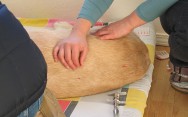Xylitol — Natural, Sweet and Tragic
Beware of Xylitol Poisoning in Dogs
Xylitol is a sugar substitute sweetener found in many products– from gum and candy to peanut butter and baked goods. Even a small amount can be fatally toxic to dogs. Many foods with xylitol are designed for diabetic people or those on low-carbohydrate diets. Xylitol tastes sweet yet is low in calories. In people it has been shown to have multiple health benefits that have made it increasingly popular in natural food stores. It is now available in a granulated form found on bakery aisle shelves at Costco and other stores. What’s not to like? In the human gastrointestinal tract it is absorbed slowly and has little effect on blood sugar. In dogs, on the other hand, it is absorbed into the bloodstream within 30 minutes. The canine pancreas confuses the xylitol with real sugar, and releases a large amount of insulin, which drastically lowers blood sugar levels. This hypoglycemia can be so rapid and severe that the dog dies very soon after ingestion. The other effect of xylitol in dogs is severe damage to the liver. The mechanism for this is not known. This can lead to internal hemorrhage, liver failure, seizures and death. It takes about ten times as much xylitol to damage the liver as it does to cause hypoglycemia.
How much does it take?
The amount of xylitol that it takes to harm a dog is quite small, and depends on the weight of the animal. Dogs who have eaten more than 100 mg of xylitol per kg of body weight should get to a veterinary clinic and be treated aggressively. Those who have ingested between 50 and 100 mg per kg of body weight should still be seen by a veterinarian and monitored for toxic effects. A dog who ingests 1000 mg per kg of body weight is at severe risk for liver necrosis. The amount of xylitol in one piece of sugar-free gum may be anywhere from 0 to 1000 mg, depending on the manufacturer and flavor. That means one stick of gum can potentially cause hypoglycemia in a 20 lb dog. A cup of granulated xylitol used in baking has 190 grams, or 190,000 mg. That calculates out to 11,875 mg per tablespoon– twice as much as it would take to cause life-threatening hypoglycemia in a 130 lb dog, and plenty to cause death by liver failure in a 25 lb dog.
How do we know? How do we make them better?
There is not currently a test for xylitol poisoning. The diagnosis is made by the history of ingestion of a product containing it, and by symptoms of vomiting, lethargy, weakness, diarrhea, collapse, seizures, and death. If the ingestion of xylitol was in gum, symptoms of hypoglycemia may not show up until several hours later. Liver failure may develop in any dog that has ingested xylitol, whether it shows signs of hypoglycemia or not.
The prognosis for dogs who have ingested xylitol depends on how much they ate and how quickly treatment is started. There is no antidote — only timely and intensive supportive care. If treatment for hypoglycemia is started early, the prognosis is good. For dogs that develop liver failure and seizures, or other neurologic symptoms, the prognosis is very poor.
The best treatment is prevention. Read labels and avoid having xylitol containing products anywhere dogs can reach them. A little dog sneaking gum out of the owner’s purse is a common scenario of poisoning. Another, more recent, problem is that now manufacturers have started to sweeten peanut butter with xylitol. Baking with xylitol is obviously dangerous for households with dogs. If there is accidental ingestion, get help as soon as you possibly can.
There have been no known poisonings of cats with xylitol.

Rosa, a beautiful 8 year old Newfoundland, and her buddy Dan, a 12 year old Labrador, were both victims of unintentional poisoning by xylitol they found when raiding the pantry shelf. This post was made in their memory.














Great information, thank you.
All pet owners should be aware of this danger, help spread the word.